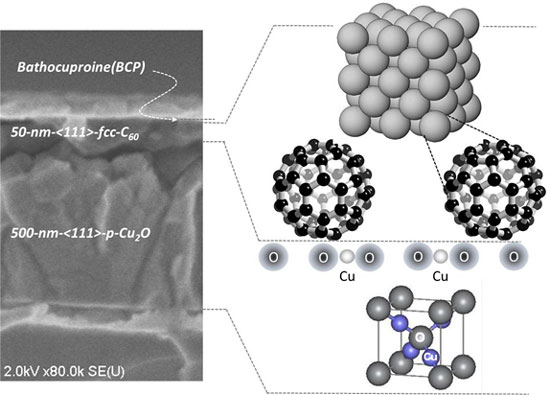| Mar 06, 2013 |
Inorganic-organic hybrid photovoltaic devices as sustainable energy generation
|
|
(Nanowerk News) Hybrid inorganic-organic photovoltaic devices are attractive as next generation high efficiency thin film solar cells, but the photovoltaic performance is still low level compared with inorganic solar cells of Si, Cu(InGa)Se2 , and organic solar cells of C60.
|
|
With this background it is necessary to investigate the fundamental aspects of these materials including the molecular configuration, energy state, and band alignment to improve photovoltaic performance.
|
|
In new work ("Hybrid Cu2O Diode with Orientation-Controlled C60 Polycrystal"), Masanobu Izaki and colleagues fabricated hybrid p-Cu2O/C60 photovoltaic device on <111>-oriented Au -coated Si substrates by electro-deposition of Cu2O layer followed by vacuum evaporation of the C60 layers as an acceptor layer.
|
 |
| FE-SEM image of the cross-section of the hybrid p-Cu2O/C60/BCP photovoltaic device and schematic illustrations of Cu2O and C60 structures.
|
|
The C60 layers exhibited face centered cubic molecular configuration on the <111>-oriented Cu2O layer, and the preferred orientation changed from random to <111> plane depending on the preparation methods.
|
|
The electrical characteristics of hybrid photovoltaic devices varied depending on the C60 molecular configuration, and a rectification characteristic with an ideality factor of approximately 1 was achieved for hybrid <111>-Cu2O/<111>-fcc- C60/ bath cuproine photovoltaic devices.
|
|
This research underscores the importance not only of the configuration of both organic and inorganic semiconductors but also of the introduction of nanostructures in the light-absorbing layer and optimization of the band alignment at the heterointerface in hybrid photovoltaic devices.
|

